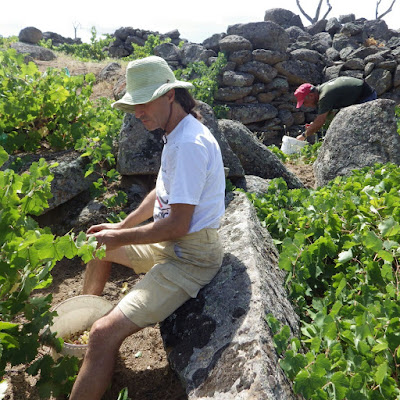Last Sunday 16th August, in accordance with my
Sparkling Master Plan, ie to make a few bottles of sparkling wine from every variety, from every
plot, and from as many states of grape ripeness as possible, I duly bottled up one (1) bottle of Albillo, from the Charco del Cura vineyard
(El Tiemblo, Sierra de Gredos), at a density of 1025.
Note: This year I'm
just going to do the 'Método Ancestral', ie just bottling up with a crown cap
(beer bottle style top) while the wine is still fermenting. Next year, perhaps,
I may consider thinking about other methods, second fermentations, degorging,
etc. But this year, I'd rather not complicate my already complicated life too
much :)
 |
| Sparkling Albillo Experiment #1 |
We decided that David
would do the opening and I would take the photos.
First though we put the
bottle in his fridge to cool and settle a little as I suspected that it got
slightly shoogled in the car on the way from my house to his shop.
So after 30 mins -
Action stations. Camara ready. Bottle opener ready. Here we go!
Good Grief! What an
eruption! What a fountain! I've never seen anything like it in my life! At
least 75% of the bottle went spurting all over the floor!
But we did get a glass
each to taste.
Extremely cloudy,
infact, totally opaque. Colour of light
mud or sludge. But appearances can be deceptive, as it was totally smooth in
the mouth. Not much fizz left after the eruption, just gently pétillant. Very
fruity in the nose, very sweet in the mouth.
 |
| Cleaning up the mess! |
So, conclusions and
lessons learned. The main one is that for future experiments I will have to do
long, slow cool fermentations, as opposed to my preferred hot n fast approach.
This is because I need time to taste a few days after bottling and if happy
with the result, the remaining wine ought to be at more or less the same stage
of fermentation. Otherwise I will miss the boat!
Another lesson learnt
is that 1025 is perhaps a bit too gassy. Maybe I'll wait until 2020 for the
next experiment.
Experiment #2
Another experiment is
underway already. It's with the same Albillo but this time bottled up at a
density 2010. This is probably not fizzy enough, but I bottled and capped the
last 15 bottles of this lot, because there wasn't enough room in the 300 liter tank
into which I had just racked the wine. Waste not want not.
Watch this space for
the results of Exp.#2. David, prepare your mop, bucket, and protective
goggles, j'arrive :)
 |
| Racking into a 300 liter stainless steel tank (on the right) |
 |
| 300 liter stainless steel tank full of Albillo wine |


















